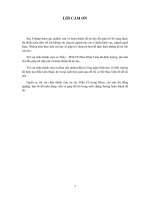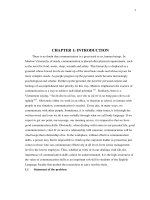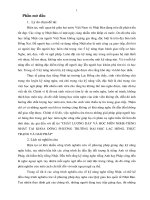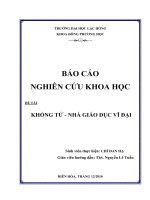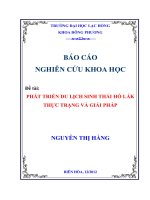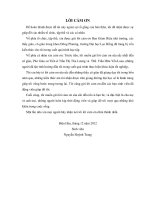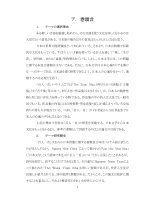Báo cáo nghiên cứu khoa học " CLAM CULTURE DEVELOPMENT IN THE INTERTIDAL AREA: EFFECTS OF STOCKING BIOMASS ON GROWTH, SURVIVAL AND PRODUCTION OF THE TWO SIZES CLAM Meretrix lyrata " docx
Bạn đang xem bản rút gọn của tài liệu. Xem và tải ngay bản đầy đủ của tài liệu tại đây (6.46 MB, 9 trang )
Collaboration for Agriculture and Rural Development
(CARD)
Program
166
CLAM CULTURE DEVELOPMENT IN THE INTERTIDAL AREA:
EFFECTS OF STOCKING BIOMASS ON GROWTH, SURVIVAL AND
PRODUCTION OF THE TWO SIZES CLAM
Meretrix lyrata
Project title:
Development of clam culture for improvement and diversificat
ion of
livelihoods of the poor coastal communities in Central Vietnam
Project c
ode
:
CARD
027/05
VIE
Author
s:
Nhu Van Can
1
, Chu Chi Thiet
1
and Martin S Kumar
2
Project implementing organizations:
1
Aquacult
ur
e
Research
Sub
-
Institute for
N
or
th C
entr
al (
AR
SIN
C)
2
South Australian Research and Development Institute (SARDI), Australia
SUMMARY
The aim of this study is to improve the productivity of traditional culture of clam, Meretrix lyrata
Sowerby, 1851 in the intertidal area of North Central Vietnam. This pa
per is mainly focused on
describing the impact of stocking biomass on the production of clam.
The triplicate experiment had been conducted in 50m
2
plots randomly placed in the intertidal areas to
evaluate the effects of stocking biomass on survival, growt
h performance and quality of clam Meretrix
lyrata Sowerby, 1851. The two stocking sizes (Mean±SD, cm) at shell length of 1.0±0.2 and 1.7±0.1
were scattered at different biomass: 0.05, 0.1, 0.2, 0.3 kg.m
-
2
and 0.34, 0.68, 1.36, 2.03 kg.m
-
2
and
named as T1,
T2, T3, T4 and T5, T6, T7, T8 respectively. Results shown that meat ratio of the clam
were similar regardless of different stocking biomass.
The fatty acids were rich in highly unsaturated
fatty acids especially docosahexaenoic acid but were variable. In c
ontrast, growth and survival of the
clam were strongly affected by the stocking biomass in which, the lower stocking biomass resulted in
higher specific growth rate (SGR) and survival rate. The biomass gained therefore was reduced
accordingly with increasi
ng of stocking biomass although the increase of final production was evident.
However, SGR and survival of the treatments T1, T2 and T3 were not significantly different explained
for the highest net profit and investment return of the treatment T3. The sto
cking biomass of 0.2 kg.m2
therefore, was recommended to maximize profit of clam cultivation.
1.
Introduction
Among mollusc species, the bivalve shellfish
meat were not only a popular seafood, but also
were regarded as the most ecologically
efficient fo
rms of aquaculture as they are low
tropic level animals.
Besides, bivalve shellfish
are filter feeders which can also be used as a
bio
-
filter for water quality improvement
(Mazzola, 2001; Shpigel, 1991; Shpigel et al.,
1997; Shpigel et al., 1993) and thus
contribute
to the sustainable aquaculture development.
Clams belong to bivalve shellfish but they are
different from the others as they live on the
bottom. Studies have been conducted for
various clam species for product
ion (Cigarrıa,
2000; Shpigelr, 1996; Zhang, 2006) and the
use of clam for water quality improvement
(Jara
-
Jara et al., 1997; Shpigel, 1990). In
Vietnam, the endogenous brackish water clam
Meretrix lyrata
is an emerging cultured species
for coastal aquacult
ure because this is a
popular seafood in the national and
international markets.
M. lyrata
distributes
naturally in the intertidal area of southern coast
and known as "Ngheu Ben Tre" because the
exploited production mostly comes from Ben
Tre province, Sout
h of Vietnam. Due to high
consumption demand, the intertidal areas are
being used for the cultivation of
M. lyrata
and
these practices expanded to the northern
CARD 027/05 VIE
–
Development of clam culture in Central Vietnam
167
coastal provinces such as in Nam Dinh, Thanh
Hoa, Nghe An, Ha Tinh. However, the clam
production
is still very unstable and
unpredictable because of poor management
due to lack of technical knowledge on clam
culture practice. The technical information on
clam culture still has been very limited. It was
therefore, necessary for research to establish a
standard clam aquaculture protocol to enhance
the production and profit of clam culture.
Among the factors that affect growth and
production, feed and feeding of clam have
been regarded as the most important factors.
Researches recently have revealed that
feed
clearance rate have positive relationship with
body size and within a range of food
concentration, their feeding can be strongly
affected by substrata (Zhuang, 2004), by
salinity or diurnal rhythm (Zhuang, 2006). For
maximizing production and profit,
Zhang
(2006) described a new three
-
phase culture
method for Manila clam farming in China. In
this method, the seed production was
artificially produced indoor for over winter and
the grow
-
out phase was conducted in the
intertidal with appropriate stocking
size,
stocking density and substrate. In the intertidal
areas where the feed are naturally dependent,
uncontrollable and variable, stocking biomass
becomes an important factor to increase
growth and production. The objective of this
research was to evalua
te the effect of stocking
biomass of the two sizes of
M. lyrata
on
growth performance and survival to enhance
the production and profit of cultivation. The
other parameters within the culture system
cannot be altered as it is a natural ecosystem
highly con
nected to capture fisheries which is
one of the key industries for the fishery
community.
2.
Research contents and methods
The experiment conducted in the intertidal
areas belongs to Hau Loc District, Thanh Hoa
Province. There were 24 plots of 50 m
2
each,
separated by plastic mesh and randomly
allocated for 8 treatments (3 replicates each).
The small clam seed at shell length of 1.0±0.2
cm were scattered at 4 different biomass: 0.05,
0.10, 0.20 and 0.30 kg.m
-
2
and named as T1,
T2, T3 and T4 respectively. T
he bigger size of
clam seed at shell length of 1.7±0.1 cm were
stocked at 4 different stocking biomass: 0.34,
0.68, 1.36 and 2.03 kg.m
2
and named as T5,
T6, T7 and T8 respectively. This experiment
was terminated after 165 days of rearing.
Intertidal cla
m culture monitoring
Environment factors such as temperature
(thermal meter), DO, pH (Oxyguard) and
turbidity (Sechi disk), salinity (Refractometer)
of water in the experiment site were daily
monitored at 3 designated points within the
experimental area.
Growth of clam, expressed in mean of shell
length (cm) and mean of live weight (g), was
determined by random sampling (n=30) and
measured every fortnight. The daily specific
growth rate (SGR) was calculated using the
following formula (Jara
-
Jara et al., 19
97):
SGR (%.day
-
1
) = 100*(LnW
f
-
LnW
i
)/t, where
W
i
and W
f
are mean of initial weight and final
weight, respectively and t is number of
experiment days.
Size variation of the clam was evaluated
according to Wang et al. (1998) in which the
mean of three rep
licates of the coefficient of
variation (CV) was used to examine the inter
-
individual variation among the clam in each
treatment: CV(%)=100*SD/M, where M is
mean of live weight and SD is standard
deviation of the clam in each treatment.
The meat ratio (% o
f meat weight. total live
weight) of clam was conducted by separating
Nhu Van Can
, Chu Chi Thiet & Martin S Kumar
168
the meat content of random samples (n = 20).
The excess water was removed by putting the
sample on tissue paper.
At the end of the experiment, clam was
randomly sampled, preserved in Li
quid
Nitrogen Biological Container (YDS
-
3,
-
196
o
C) for fatty acids analysis at the
Laboratory.
All data of the treatments were tested for
significant differences (p<0.05) using One
-
way
ANOVA followed by Turky test for multiple
comparisons of means. The da
ta are expressed
as Average±SD and statistical analyzed was
performed using GraphPad Prism version 4.0
and Microsoft Office EXCEL for Window.
3.
Results and discussions
3.1
The environment conditions of the
experiments
The experiment site was situated
in the intertidal
areas near the estuary where the clams have been
already cultivated for recent years. The
environment factors such as DO, water
temperature, pH and salinity (table 1) were
regarded as the best conditions for clam
development. The high lev
els in salinity
fluctuation is typical for estuary ecological
conditions. However, during the culture the
salinity fluctuation was minimal with average
salinity 25.65±2.84. The average water
temperature was 23.59±2.40
o
C, relatively low
compared to the norm
al water temperature in the
south of Vietnam, where
M. lyrata
naturally
distributes.
Table 1
. Environment conditions in the experiment site
Parameters
DO (ppm)
Water temperature
(
o
C)
pH
Salinity (ppt)
Turbidity
(cm)
Average±SD
6.25±0.42
23.59±2.40
25.
65±2.84
9.05±3.13
Maximum
7.66
31.00
8.99
31.00
20.00
Minimum
5.50
19.50
7.21
20.00
5.00
Temperature plays an important role in growth,
survival rate of the animals. The low water
temperature affects the metabolic rate and feed
availability in the wat
er which in turn affect
growth performance and survival rate of
M.
lyrata.
Soudanta et al. (2004) has described, the
Manila clam conducted in four rearing sites
selected for their varied ecological characteristics,
the environmental conditions were found h
aving
effect to the physiological and immunological
parameters
.
3
.2
Growth performance
The growth performance of the two stocking
sizes of
M. lyrata
at different stocking biomass
expressed in specific growth rate, final shell
length and final live weight
as well as size
variation are shown in the table 2 and table 3.
CARD 027/05 VIE
–
Development of clam culture in Central Vietnam
169
Table 2
. Growth performance of clam at stocking size of 1.0cm
Treatments
T1 (0.05kg.m
2
)
T2 (0.1kg.m
2
)
T3
(0.2kg.m
2
)
T4
(0.3kg.m
2
)
SGR
1.25±0.05
a
1.13±0.05
a
1.08±0.10
ab
0.94±0.37
b
Fina
l length (cm)
2.04±0.13
a
2.01±0.09
ab
1.95±0.10
b
1.95±0.11
b
Final weight (g)
5.92±1.08
a
5.76±0.81
ab
5.46±0.76
ab
5.30±0.85
b
% of meat.total weight
15.87±1.00
a
15.48±2.72
a
15.53±1.02
a
15.15±5.47
a
CV% (weight)
28.72±2.55
a
23.07±0.24
b
23.73±1.55
b
27.78±2.11
a
b
Table 3
. Growth performance of clam at stocking size of 1.7cm
Treatments
T5(0.34kg.m
2
)
T6(0.68kg.m
2
)
T7(1.36kg.m
2
)
T8(2.06kg.m
2
)
SGR
0.62±0.04
a
0.46±0.03
b
0.33±0.02
c
0.32±0.02
cd
Final length (mm)
2.36±0.17
ab
2.40±0.10
2.32±0.11
bc
2.27±0.10
c
Final wei
ght (g)
9.24±1.20
a
9.33±0.95
a
8.90±1.12
a
8.21±1.01
b
% of meat.total weight
14.53±1.89
a
15.78±2.35
a
16.53±0.62
a
15.48±1.31
a
CV% (weight)
22.3±0.45
a
19.05±5.16
a
18.69±3.36
a
22.73±4.16
a
For the small size group, there was no significant
difference in spe
cific growth rate and final
weight among T1, T2 and T3 treatments (table 2)
indicating that growth of the clams
was
not be
affected by the stocking biomass below 0.2 kg.m
-
2
. The final size of
M. lyrata
was more variable at
low (T1) and high (T4) stocking d
ensity
compared to the medium (T2 and T3) ones. The
meat yield expressed in percentage of meat per
total weight, which is regarded as the most
valuable part of the clams was not significantly
different (p>0.05) in all treatments
The growth of
M. lyrata
at
stocking size of 1.7
cm was significantly reduced with increased
stocking biomass (table 3). At a high stocking
biomass (T7 and T8), the SGRs were relatively
low and were not significantly different. The
final length and final weight of the treatment
T8 we
re significantly smaller than the others.
The size variation however, was not affected
by different stocking biomass.
Table 4.
Biomass production of clam at stocking size of 1.0cm
Treatments
T1
(0.05kg.m
2
)
T2 (0.1kg.m
2
)
T3
(0.2kg.m
2
)
T4
(0.3kg.m
2
)
Final
production (ton.ha
-
1
)
4.14±0.57
a
6.82±0.56
a
12.62±2.16
b
14.84±0.91
b
Biomass gained (ton.ha
-
1
)
3.62±0.57
a
5.78±0.56
a
10.54±2.16
b
11.72±0.91
b
% of biomass gained
697.1±109.4
a
555.8±53.6
ab
506.9±104.0
ab
375.8±29.3
b
Nhu Van Can
, Chu Chi Thiet & Martin S Kumar
170
T
able 5.
Biomass production of clam a
t stocking size of 1.7cm
Treatments
T5(0.34kg.m
2
)
T6(0.68kg.m
2
)
T7(1.36kg.m
2
)
T8(2.06kg.m
2
)
Final production (ton.ha
-
1
)
9.49±0.68
a
14.46±0.69
b
23.58±0.68
c
34.80±1.00
d
Biomass gained (ton.ha
-
1
)
6.10±0.68
a
7.68±0.69
a
10.02±0.69
b
14.46±0.99
c
% of biomass g
ained
180.0±20.0
a
113.3±10.1
b
73.9±5.1
c
71.1±4.8
c
Generally, at a younger stage, the animal has a
better grow rate. In the case of clam, at the
same stocking biomass, the small sized clam
(1.0 cm) grew much better than the bigger size
(1.7 cm). In the i
ntertidal areas, the natural
feed and environmental factors are
uncontrollable and are dependent on nature.
Dynamics of tide, wave and current create the
availability of algae, organic matter that are
regarded as feed for clam. However, clam is a
filter fe
eder and passively dwells on the
bottom. If the clam biomass levels increase
beyond a certain level, the natural feed might
not be enough for growing. Moreover, in the
same size treatments, increasing biomass leads
to increasing the competition of other
en
vironmental conditions such as habitat, DO
and increasing metabolic wastes accumulated
such as faces, which are regarded as a
detriment to the clam growing (Yan et al.,
2006). It was also investigated that at the same
temperature, the clearance rate and in
gestion
rate of clam were increased exponentially with
increasing in size (Zhuang, 2004). Results of
growing performance (table 3) indicated that at
high stocking biomass (more than 0.3 kg.m
-
2
),
the growing could be inhibited and the growth
rate was signif
icantly reduced with increasing
biomass. It is also noted that the culture period
was winter time of the year when water
temperatures are normally low and not
appropriate for growing
M. lyrata.
3.3
Survival
The stocking biomass impacted the survival
rate i
n both sizes of clam stocked. Survival
was very high in the low stocking biomass
treatment (T1) and was almost similar in the
treatment T2 and T3. The treatment T1 was
significantly different (p<0.05) to treatment T4
(Fig 1). In the bigger stocking groups,
survival
of the treatment T5 was the highest followed
by the treatment T6. Survival of the treatment
T7 and treatment T8 were very low and were
not significantly different (Fig 2). On the other
hand, the results present in the fig 1 and fig 2
also indicat
ed that the clam survival was not
only affected by stocking biomass but also by
the stocking density. The environmental
condition and food availability could be
explained as the main reasons for the impact of
the stocking biomass on survival rate.
T1
T2
T3
T4
50
60
70
80
90
100
110
a
ab
ab
b
C la m at sto c king siz e o f 1 .0 c m
Survival(%)
Figure
1
.
Survival of clam size 1.0 cm rearing
at
different stocking biomass
Value (Average±SD) followed by different
superscript letters are significantly different
(p<0.05). T1, T2, T3 and T4 are treatments of
clam cultured at 0.05, 0.1, 0.2 and 0.3 kg.m
-
2
res
pectively.
CARD 027/05 VIE
–
Development of clam culture in Central Vietnam
171
T5
T6
T7
T8
5 0
6 0
7 0
8 0
9 0
1 0 0
1 1 0
a
b
c
c
C la m a t s to c kin g s iz e o f 1 .7 c m
Survival(%)
Figure
2
.
Survival of clam size 1.7 cm rearing
at different stocking biomass
Value (Average±SD) followed by different
superscript letters are significantly different
(
P
<0.05). T5, T6, T7 and T8 are treatments of
clam size 1.7cm cultured at 0.
34, 0.68, 1.36
and 2.06 kg.m
-
2
respectively.
Stocking size had been detected effecting
survival of the Manila clam, in which, the
small size was showing higher mortality,
because of the quality of substrata or predator
s
(Cigarrıa and Fernandez, 2000) and the normal
stocking size of this species for intertidal
cultivation was 1.0 cm (Zhang, 2006). In our
trial, at same stocking biomass (0.30 and 0.34
kg.m
-
2
), survival rate of treatment T4 (1.0 cm)
were very low (55%) com
pared to the survival
rate of 90% in the treatment T5 (1.7 cm).
Within the same size 1.7 cm, the treatment T7
and T8 had a relatively low survival compared
to the treatment T5 and T6 meaning those
stocking biomass were too high for the clam
development.
3.
4
Production and quality
The production of clam derived from both
growth and survival. There was a positive
relationship of the clam production and
stocking biomass although the growth and
survival were negatively affected. Among the
small stocking size gr
oup, the final production
was increasing accordingly with the biomass
gained and no significant difference (p>0.05)
was detected between T1 and T2 nor T3 and
T4 (table 4). The percentage of biomass
gained, in contrast, was showing a reduction in
trend when
increasing the stocking biomass.
There was no significant difference between
T1 and T4 was detected. This is due to the fact
that the increase in biomass negatively affected
the growth and survival of the clams.
In the bigger stocking size (1.7 cm), the f
inal
production of the clam was significantly
increased with increasing of stocking biomass
(p<0.05). The percentage of biomass gained, in
contrast, was reduced with increasing stocking
biomass in T5, T6 and T7 (table 5). However,
there was neither signifi
cant difference
(p>0.05) in the biomass gained in the treatment
T5 and T6 nor percentage of biomass gained in
the treatments T7 and T8. In both size groups,
the increase in biomass certainly impacted on
net production negatively.
The high value of percenta
ge of biomass
gained confirmed that the stocking biomass
was a barrier for clam development. However,
the increasing of the biomass gained as well as
final production indicated that benefit can be
obtained if the appropriate stocking biomass
was determined
. The economics of culture
therefore is vital to optimize investment
benefit.
3.5
Fatty acid profile
There was variable in the fatty acid profile
between treatments regardless of different
stocking biomass. The total FAME varies from
134.4 to 193.7 mg.g
-
1
dry weight (table 6).
However, the present of a high content of
HUFA especially DHA content (29.00 to 62.77
mg.g
-
1
dry weight indicated the value of clam as
a seafood product. The variation of fatty acids
of clam may relate to the ovary and. or growing
dev
elopment stage when the fatty acids
normally accumulated. Our result confirmed the
variation of fatty acid of clam
Ruditapes
decussatus
reared in sea water and effluent from
a fish farm in Galicia (Jara
-
Jara et al., 1997).
The fatty acid variation and the
factors affecting
to this variation need further research.
Nhu Van Can
, Chu Chi Thiet & Martin S Kumar
172
Table 6.
Fatty acids of clam cultured at different stocking sizes and different stocking biomass
Fatty Acids
T1
T2
T3
T4
T5
T6
T7
T8
14:00
0.58
-
-
1.07
-
0.59
2.52
6.35
16:00
44.26
42.67
78.
27
21.63
47.07
84.63
33.54
33.94
16:1(n
-
7)
9.85
-
3.53
7.88
-
0.75
10.94
11.71
17:00
0.19
-
-
0.89
-
-
1.94
1.22
17:1(n
-
7)
-
-
-
-
-
-
3.39
7.71
18:00
4.63
15.63
22
23.98
16.82
7.84
10.08
10.72
18:1(n
-
9)
63.02
39.79
26.83
29.68
49.38
33.41
27.18
31.94
18:1(n
-
7)
-
-
-
5.31
6.33
-
-
-
18:2(n
-
6)t
0.41
8.19
-
1.06
-
-
2.35
13.74
18:3(n
-
3)
-
-
-
0.54
-
-
1.1
5.16
20:1(n
-
9)
-
7.83
-
0.52
8.18
-
-
-
20:4(n
-
6)
1.11
-
7.72
2.98
5.06
2.72
3.54
8.9
20:4(n
-
3)
-
-
-
0.31
-
-
-
-
20:5(n
-
3)
4.45
3.11
-
5.95
6.
2
0.97
7.96
3.29
24:00:00
-
-
-
1.17
-
-
-
-
22:5(n
-
6)
-
-
-
-
-
-
1.56
-
22:5(n
-
3)
-
3
4.96
1.85
-
-
2.46
-
22:6(n
-
3)
45.78
29
33.62
29.65
27.58
62.77
30.4
30.0
Sum (n
-
3)
50.23
35.11
38.58
37.76
33.78
63.74
40.82
30.29
Sum (n
-
6)
0.11
0
7.72
2.98
5.0
6
2.72
5.1
8.9
Sum HUFA
50.34
35.11
46.3
40.74
38.84
66.46
45.92
42.19
Total FAME
174.3
149.2
176.9
134.4
166.6
193.7
139
166.1
Value = mg.g
-
1
dry weight; t1, t2, t3 and t4 are treatments of clam cultured at 0.05, 0.1, 0.2 and 0.3
kg.m
-
2
respectively; t
5, t6, t7 and t8 are treatments of clam size 1.7cm cultured at 0.34, 0.68, 1.36 and
2.06 kg.m
-
2
respectively.
3.6. Economic evaluation
The estimation of the economic benefit of clam
cultured in the intertidal areas is showed in table
7. The net profit is
calculated based on the output
cost and input cost and price of the clam.
The main cost in
M. lyrata
cultivation was the
expense in seed purchase. Cost of seed ranged
between 46% to 81% in small size seed (1.0
cm) for the four treatments (T1, T2, T3 & T4
).
As all other costs were fixed, the increase in
stocking biomass increased the total cost
invested. Although total production increased
with the increase in stocking biomass, the
economic analysis clearly indicated that the net
profit decreased beyond th
e level of 2 ton.ha
-
1
stocking biomass (T3). The treatment T4 with
the stocking density of 3 ton.ha
-
1
yielded
lesser net profit compared to the treatment T3.
This can be explained by the higher proportion
of seed cost while the biomass gained was
lower du
e to lesser growth and survival.
Therefore, the stocking biomass of 2 ton.ha
-
1
is
recommended for
M. lyrata
at a stocking size
of 1.0 cm. For the treatment T5, T6, T7 and
T8, cost of seed increased from 73.8% to
92.9%.
CARD 027/05 VIE
–
Development of clam culture in Central Vietnam
173
Table 7.
Economical evaluationof
the twostocking size ofclamrearing at different stocking biomass
Stocking size
Shell length 1.0 cm
Shell length 1.7 cm
Treatments
T1
T2
T3
T4
T5
T6
T7
T8
Stocking biomass (ton.ha
-
1
)
0.50
1.00
2.00
3.00
3.40
6.80
13.60
20.40
Final production (ton.ha
-
1
)
4.14
6.82
12.62
14.84
9.49
14.46
23.58
34.80
Input (* mill VND.ha
-
1
)
Cost for seed (1)
17.50
35.00
70.00
105.00
61.20
122.40
244.80
367.20
Mesh and fencing
3.30
3.30
3.30
3.30
3.30
3.30
3.30
3.30
Labour cost
7.20
7.20
7.20
7.20
7.20
7.20
7.20
7.20
Hut for daily monitoring
5.00
5.00
5.00
5.00
5.00
5.00
5.00
5.00
Land lease
4.00
4.00
4.00
4.00
4.00
4.00
4.00
4.00
Harvesting cost (B*2%)
0.99
1.64
3.03
3.56
2.28
3.47
5.66
8.35
Total input (A)
37.99
56.14
92.53
128.06
82.98
145.37
269.96
395.05
Outp
ut (* mill VND.ha
-
1
with assumption price of 12 mill VND.ton
-
1
for all harvested clam)
Total output (B)
49.72
81.82
151.44
178.08
113.90
173.52
282.96
417.60
Net profit (A
-
B)
11.72
25.68
58.91
50.02
30.93
28.15
13.00
22.55
Rate of investmentreturn (
%)
30.85
45.75
63.67
39.06
37.27
19.36
4.82
5.71
(1) the seed cost were 0.035 mill vnd.kg
-
1
size 1.0 cm and 0.018 mill vnd.kg
-
1
size 1.7 cm
Since the price of seed was higher than the price
of harvested clam, while the biomass gained
reduced accordingly
with increasing of stocking
biomass, the net profit was reduced and was
relatively lower compared to the 1 cm seed
stocking treatments. We suggested that the clam
of size more than 1.7 cm should not be cultured
at a stocking biomass of more than 6.8 ton.ha
-
1
.
4.
Conclusions and recommendation
s
The result of this experiment indicated that
M.
lyrata
grew very well in the intertidal areas in
the North coast of Vietnam during winter at
water temperature of 23.59±2.40
o
C. The
stocking biomass had a strong effec
t on the
growth performance and survival of clam. For
the stocking seed at shell length of 1.7 cm,
among 4 different stocking biomass 0.34, 0.68,
1.36 and 2,04 kg.m
-
2
, the higher the biomass,
the lower was the growth performance and
lower survival, which
eventually resulted in
reduction in the net profit For the small seed
at shell length of 1.0 cm, among stocking
biomass of 0.05, 0.1, 0.2 and 0.3 kg.m
-
2
, the
lower stocking biomass resulted in better
growth performance. The survival rate of the
stocking
biomass of 0.3 kg.m
-
2
however, was
significantly lower than the others resulting in
the highest net profit as well as investment
return, obtained at the stocking biomass of 0.2
kg.m
-
2
. Based on the results, 0.2 kg.m
-
2
stocking biomass is recommended for
in
tertidal clam culture.
Quality of the clam expressed as the meat ratio
of clam was similarly regardless of different
stocking size or stocking biomass. In addition,
the fatty acids of clam were rich in HUFAs
especially DHA and EPA but also were varied
in t
he treatments. This might be related to the
natural feed availability or the different gonad
developmental/maturation stages of animals.
Nhu Van Can
, Chu Chi Thiet & Martin S Kumar
174
References
1.
Cigar
rıa, J., Fernandez, J.M., 2000.
Management of Manila clam beds I.
Influence of seed size, type of substratum
and protection on initial mortality.
Aquaculture 182, 173
-
182.
2.
Gibbs, M.T., 2004. Interactions between
bivalve shellfish farms and fishery
resource
s. Aquaculture 240, 267
-
296.
3.
Jara
-
Jara, R., Pazos, A.J., Abad, M.,
Garcia
-
Martin, L.O., Sanchez, J.L., 1997.
Growth of clam seed (
Ruditapes
decussatus
) reared in the wastewater
effluent from a fish farm in Galicia (N. W.
Spain). Aquaculture 158, 247
-
262.
4.
M
azzola, A., Sara, G., 2001. The effect of
fish farming organic waste on food
availability for bivalve molluscs (Gaeta
Gulf, Central Tyrrhenian, MED): stable
carbon isotopic analysis. Aquaculture 192,
361
-
379.
5.
Shpigel, M., Fridman, R., 1990.
Propagation of
the Manila clam (
Tapes
semidecussatus
) in the effluent of fish
aquaculture ponds in Eilat, Israel.
Aquaculture 90, 113
-
122.
6.
Shpigel, M., Blaylock, R.A., 1991. The
Pacific oyster
Crassostrea gigas
as a
biological filter for a marine fish
aquaculture pond. A
quaculture 92, 187
-
197.
7.
Shpigel, M., Spencer, B., 1996.
Performance of diploid and triploid Manila
clams (
Tapes philippinarum
, Adams and
Reeve) at various levels of tidal exposure
in the UK and in water from fish ponds at
Eilat, Israel. Aquaculture 141, 15
9
-
171.
8.
Shpigel, M., Gasith, A., Kimmel, E., 1997.
A biomechanical filter for treating fish
-
pond effluents. Aquaculture 152, 103
-
117.
9.
Shpigel, M., Neori, A., Popper, D.M.,
Gordin, H., 1993. A proposed model for
"environmentally clean" land
-
based culture
of
fish, bivalves and seaweeds.
Aquaculture 17, 115
-
128.
10.
Soudanta, P., Paillarda, C., Choqueta, G.,
Lamberta, C., H.I. Reidb, Marhica, A.,
Donaghya, L., Birkbeck, T.H., 2004.
Impact of season and rearing site on the
physiological and immunological
parameters
of the Manila clam
Venerupis
(=Tapes, =Ruditapes) philippinarum
.
Aquaculture 229, 401
-
418.
11.
Tacon, A.G.J., Halwart, M., 2006. Cage
culture: a global overview, Second
International Symposium on Cage
Aquaculture in Asia, Hangzhau, P. R.
China.
12.
Wang, N., Haywa
rd, R.S., Noltie, D.B.,
1998. Effect of feeding frequency on food
consumption, growth, size variation, and
feeding pattern of age
-
0 hybrid sunfish.
Aquaculture 165, 261
-
267.
13.
Yan, X., Zhang, G., Yang, F., 2006.
Effects of diet, stocking density, and
environ
mental factors on growth, survival,
and metamorphosis of Manila clam
Ruditapes philippinarum
larvae.
Aquaculture 253, 350
-
358.
14.
Zhang, G., Yan, X., 2006. A new three
-
phase culture method for Manila clam,
Ruditapes philippinarum
, farming in
northern China. A
quaculture 258, 452
-
461.
15.
Zhuang, S., 2006. The influence of
salinity, diurnal rhythm and daylength on
feeding behavior in
Meretrix meretrix
Linnaeus. Aquaculture 252, 584
-
590.
16.
Zhuang, S.H., Wang, Z.Q., 2004. Influence
of size, habitat and food concentratio
n on
the feeding ecology of the bivalve,
Meretrix meretrix
Linnaeus. Aquaculture
241, 689
-
699.

